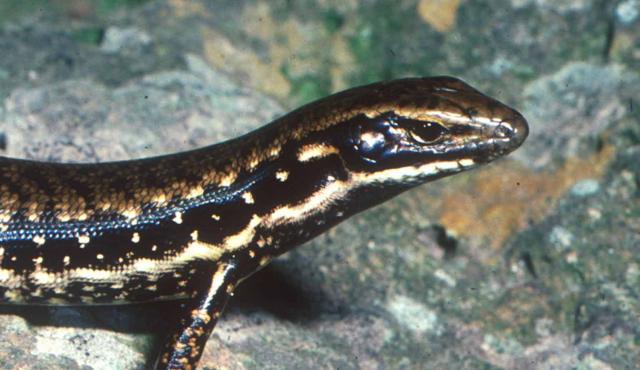A range of teacher professional learning programs will be developed to accompany the Biodiversity of the Western Volcanic Plains online outreach...


Corangamite Water Skink
Eulamprus tympanum marnieae
Viviparous (live young). Produces 1 to 6 live young each year in late December. Litter mass and size increases with female size. Diurnally active, basking skink.
| Details | Description |
| Type | Reptile |
| Group | Lizard |
| Identifying Characteristics | |
| Distinctive Markings | Heavy irregular broken black stripe extending from the snout along the sides to the hind limbs. Limbs have heavy black stripes and blotches. |
| Diet | Omnivore. Predominantly insectivorous feeding on both terrestrial prey including spiders, beetles and ants, and aquatic prey including mayfly and dragonfly larvae. Also feeds on the fruit of the Victorian Volcanic Plains Tree Violet (Melicytus sp.). |
| Habitat | Restricted to sites between Colac and Lake Bolac. Occurs in deeply fissured basaltic rock piles or remnant shrubs near permanent or ephemeral wetlands. |
| Native Status | Native to Australia |
| Taxonomy | |
| Phylum | Chordata |
| Class | Reptilia |
| Order | Squamata |
| Family | Scincidae |
| Genus | Eulamprus |
| Species | tympanum marnieae |

Distribution maps indicate current and historic locations where species have been sighted.
Source: Atlas of Living Australia
| Conservation Status | |
| DEPI Advisory List | Critically endangered |
| FFG Act | Listed as threatened |
| EPBC Act | Endangered |
| FFG Action Statement |
The conservation status of species is listed within Victoria and Australia.
The Department of Environment and Primary Industry (DEPI) Advisory List consists of non-statutory advisory lists of rare or threatened flora and fauna within Victoria.
The Flora and Fauna Guarantee Act 1988 (FFG Act) lists threatened species in Victoria. Under the Act, an Action Statement is produced for each listed species.
The Environment Protection and Biodiversity Conservation Act 1999 (EPBC Act) is the Australian Government’s key piece of environmental legislation, listing nationally threatened native species and ecological communities.



